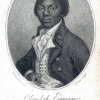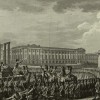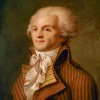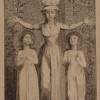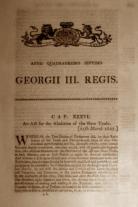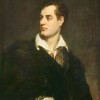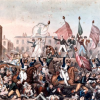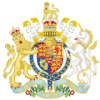Age of Romanticism - Collaborative Timeline - Spring 2021
Created by Amy Gates on Mon, 02/01/2021 - 21:55
Part of Group:
 This timeline is part of the ENG 272 collaborative "Age of Romanticism" Timeline, one element of the Image, Event, Place Project. Add one timeline element that is related or relevant in some way to the work we have been reading in the first several weeks of class. Provide sufficient detail to explain the historical or cultural detail and, perhaps, how it relates to one or more literary works we have read. Be sure to cite your source(s) using MLA bibliographic conventions. A few timeline elements, borrowed from BRANCH, have already been added.
This timeline is part of the ENG 272 collaborative "Age of Romanticism" Timeline, one element of the Image, Event, Place Project. Add one timeline element that is related or relevant in some way to the work we have been reading in the first several weeks of class. Provide sufficient detail to explain the historical or cultural detail and, perhaps, how it relates to one or more literary works we have read. Be sure to cite your source(s) using MLA bibliographic conventions. A few timeline elements, borrowed from BRANCH, have already been added.
This assignment is modeled on assignments created by Professor Dino Franco Felluga (Purdue University).
Timeline
Chronological table
| Date | Event | Created by | Associated Places | |
|---|---|---|---|---|
| 3 Sep 1536 |
Dissolution of the Tintern Abbey MonasteryWhile Tintern Abbey had already suffered the consequences of the Black Death in the 1300s, the Dissolution of the Monasteries, enacted by King Henry VIII in the 1500s in an effort to control the church completely, effectively ended the the monastery at Tintern Abbey. On September 3, 1536, Abbot Wyche surrendered the abbey. After this event, Tintern was left to fall into ruin without the monks there to keep it up. Left alone to rot, it wasn't until the 18th century that the abbey became popular as a tourist sight. It was considered a cultured outing for gentleman and ladies at the time, given its beautiful surrounding country and aesthetic ruined state. Artists came to sketch the ruins, while poets came to be inspired. This is the case of "A Few Lines Composed Above Tintern Abbey" by William Wordsworth - perhaps the most popular but definitely not the only poet to see the abbey. |
Myranda Morse | ||
| Nov 1688 to Jan 1689 |
The Glorious RevolutionThe Glorious Revolution that Richard Price compared to the French Revolution in his “A Discussion on the Love of Our Country” began in 1688 and ended shortly after. The revolution is arguably the event that created the Constitutional Monarchy in England. The Catholic King James II was removed from power and replaced by his Protestant daughter Mary and William of Orange. The revolution was initiated in November of 1688 with William of Orange’s invasion of Torbay, Devon, and concluded in January 1689 with the meeting of the Convention Parliament. At the meeting of the Convention Parliament, the English Bill of Rights was created. The Bill of Rights recognized the right for regular Parliament, free elections, and freedom of speech. The new king and queen accepted more Parliamentary restrictions than any other monarch in history. History.com Editors. “Glorious Revolution.” History.com, A&E Television Networks, 20 Feb. 2018, www.history.com/topics/british-history/glorious-revolution. |
Emily Whitehurst | ||
| 7 Apr 1770 |
Birth and Early life of William WordsworthWilliam Wordsworth was born April 7, 1770, Cockermouth, Cumberland, England- died April 23, 1850. The English poet was a co-author of Lyrical Ballads (1798), helped launch the English Romantic movement. Wordsworth was the second of five children and lost both parents at a young age. The boys in the Wordsworth family were sent off to grammar school by their uncles. There Wordsworth was educated in the arts of literature, classics, and mathematics. Later in life, Wordsworth studied at St. John's College, Cambridge. After graduation, Wordsworth was living with his sister Dorothy and became friends with a poet Samual Taylor Coleridge. Through their friendship bloomed Lyrical Ballads. Sadly Coleridge and Wordsworth did not agree on everything, during the process of creating and publishing Lyrical Ballads, and they didn't remain friends for long. Bibliography Parrish, Stephen Maxfield. "William Wordsworth". Encyclopedia Britannica, 17 Dec. 2020, https://www.britannica.com/biography/William-Wordsworth. Accessed 9 February 2021. “William Wordsworth.” Poetry Foundation, Poetry Foundation, www.poetryfoundation.org/poets/william-wordsworth. |
Andrea Day | ||
| 1786 |
Wollstonecraft Procures Employment as a GovernessIn 1786, Wollstonecraft become the governess to Viscount Kingsborough in Ireland (Stanford Encyclopedia of Philosophy). Though Stanford does not offer specifics, they note that Wollstonecraft was unsatisfied with her employment and left; shortly thereafter, she published Original Stories from Real Life... her children's book. Importantly, Stnadford does note that Wollstonecraft was frustrated with the lack of reputable employment opportunities available for women which in the period were "...a lady’s companion, a schoolteacher, and a governess," and this impediment to financial stability and intellectual discouse was the impetus for her to start a serious writing career (Standford Encyclopedia of Philosophy). Systemic sexism and misogyny with Britain would prompt Wollstonecraft to write her, arguably, most well-known work A Vindication of the Rights of Woman... in 1792. |
SARAH HASKINS | ||
| 1789 |
The Guillotine is InventedThe guillotine that would kill the French Monarchy is invented |
Abigail Russell | ||
| Jan 1789 |
Interesting Narrative of the Life of Olaudah Equiano
Articles |
David Rettenmaier | ||
| 1789 |
The French Revolution 1789The French Revoltion was what spurred a lot of the literature we have read. Many people were tired of the aristocracy taking advantage of the working class. "Let them eat cake," Marie Antoinette famously (allegedly) said when the working class asked for bread. When the working class gets angry, revolution happens. Created by Abigail Russell on Thu, 02/11/2021 - 13:14; moved by ALG, 3/18/21 |
Amy Gates | ||
| circa. Spring 1789 to circa. Autumn 1799 |
French RevolutionThe French Revolution was one of the major events and a turning point in history. The reasons behind the revolution was that there was international affairs meaning that the "empire outstrips the fiscal resources of the state". Another one is political conflict which is the people's disagreement and the taxes that they laid on them. The Enlightenment was another big part of this. It introduces a "good government" which is talked about in Rousseau's Social Contract. Then there was King Louis XVI who was unreasonable to his people. People started to revolt against the government and King which soon led the king being executed by his own people. It may be called the French Revolution, but it still affected other countries like England. Thomas Paine, an England writer, wrote a book around the time of the revolution called The Rights of Man. The book talks about how a revolution is a right thing when the government can't protect their people. Paine's book was also arguing with Edmund Burke at the time because Edmund believed that revolutions were wrong. Back on the topic though, Paine believes in this thing called "Natural Rights". This is a quote from Thomas Paine about Natural Rights: "Natural Rights are those which always appertain to man in right of his existence. Of this kind are all the intellectual rights, or rights of the mind, and also all those rights of acting as an individual for his own comfort and happiness, which are not injurious to the rights of others." Paine is saying that man should have control of their own body. That they shouldn't need someone to tell them on how they should live their life, or what ruler that they should be worshipping. Every human being works in different ways . This is what Thomas Paine was trying to get at, and this is why he supported the French Revolution. He liked how he saw the citizens over in French stand up for their rights. This all ties into romanticism because this focuses on human nature. Some people like how the country is being ran, but there are other people that want change. I get that a lot of people can't agree all on one thing, but people will soon start sensing when things are getting bad when they know they are getting treated unfairly. |
Zachary Mitchell | ||
| 5 May 1789 to 10 Nov 1799 |
French Revolution
On 5 May 1789, the Estates-General, representing the nobility, the clergy, and the common people, held a meeting at the request of the King to address France’s financial difficulties. At this meeting, the Third Estate (the commoners) protested the merely symbolic double representation that they had been granted by the King. This protest resulted in a fracture among the three estates and precipitated the French Revolution. On 17 June, members of the Third Estate designated themselves the National Assembly and claimed to represent the people of the nation, thus preparing the way for the foundation of the republic. Several pivotal events followed in quick succession: the storming of the Bastille (14 July), the approval of the Declaration of the Rights of Man and of the Citizen (26 August), and the march on Versailles that led to the enforced relocation of the royal family to Paris (5-6 October). These revolutionary acts fired the imagination of many regarding the political future of France, and, indeed, all of Europe. The republican period of the revolution continued in various phases until 9-10 November 1799 when Napoleon Bonaparte supplanted the government. ArticlesDiane Piccitto, "On 1793 and the Aftermath of the French Revolution" |
David Rettenmaier | ||
| The middle of the month Summer 1789 |
The Storming of the BastilleThis event kicked off the French Revolution |
Abigail Russell | ||
| The start of the month Autumn 1789 |
Women's March on VersaillesWoman march around 12 miles to Versailles to demand lower bread prices |
Abigail Russell | ||
| 1 Jan 1792 |
Vindication of the Rights of Woman
ArticlesAnne K. Mellor, "On the Publication of A Vindication of the Rights of Woman" Related Articles |
David Rettenmaier | ||
| 21 Jan 1793 |
Execution of King Louis XVI
1793 was a key juncture in the revolution, beginning with this execution on 21 January. The increasing violence prompted Britain to cut its ties to France, leading to declarations of war by the two countries. Violence peaked during the Reign of Terror (5 September 1793 – 27 July 1794), which resulted in the execution of the Queen (16 October) as well as of many suspects of treason and members of the Girondins, the more moderate faction that the radical Jacobins brought down on 2 June 1793 ArticlesDiane Piccitto, "On 1793 and the Aftermath of the French Revolution" |
David Rettenmaier | ||
| 5 Sep 1793 to 27 Jul 1794 |
Reign of Terror
On 5 September 1793, the National Convention, France’s ruling body from 1793 to 1795, officially put into effect terror measures in order to subdue opposition to and punish insufficient support for the revolution and the new regime. From the autumn of 1793 until the summer of 1794, thousands of people across the country were imprisoned and executed (including the Queen) under the ruthless leadership of Maximilien Robespierre. The guillotine, particularly the one in Paris’s Place de la Révolution, served as the bloody emblem of the fear tactics that began to manifest themselves first in the formation of the Committee of Public Safety (6 April 1793) and subsequently in the implementation of the Law of Suspects (17 September 1793). The Terror ended on 27 July 1794 with the overthrow of Robespierre, who was guillotined the next day. ArticlesDiane Piccitto, "On 1793 and the Aftermath of the French Revolution" |
David Rettenmaier | ||
| 1797 |
Wordsmith and ColeridgeThe friendship between Samuel Taylor Coleridge and WIlliam Wordsmith began in 1797 which was the day they met. They were however aware of each others work before hand and met very briefly in 1795 both acknowledging that the other seemed to have considerable talent. after their meeting in 1797 they spoke often and a year later published their conjoined work of the, "lyrical Ballads". this was however the hieght at which their relationship would grow together. despite their love of imaginiation in poems they had many differences in opinion when it came to their future work. they begun to critice eachother's work and had different views on the use and reason behind poetry however the final blow was when coleridge had been told that Wordsmith called him a burden and a rotten drunk. this was not true and made up by Basil Montagu. in the end Coleridge was more concerned with the supernatural and Wordsmith was concerned with the everyday things. this simple point would tear them apart. “Samuel Taylor Coleridge in Contrast to William Wordsworth | InfoRefuge.” InfoRefuge, 14 July 2011, inforefuge.com/compare-contrast-coleridge-wordsworth. |
Devin Worstell | ||
| 10 Sep 1797 |
Death of Wollstonecraft
ArticlesAnne K. Mellor, "On the Publication of A Vindication of the Rights of Woman" |
David Rettenmaier | ||
| 1798 |
Lyrical BalladsLyrical Ballads is a collection of poems created by Samual Taylor Coleridge and William Wordsworth and first published in 1798. Lyrical Ballads is known as the beginning of English Romanticism by scholars. Bibliography Britannica, The Editors of Encyclopaedia. "Lyrical Ballads". Encyclopedia Britannica, 27 Mar. 2020, https://www.britannica.com/topic/Lyrical-Ballads. Accessed 9 February 2021. |
Andrea Day | ||
| Spring 1800 to Autumn 1804 |
William Blake Becomes Charged with SeditionIn the year 1800, Blake was invited by the poet William Hayley to live in Felpham and work as a protégé under Hayley. During this time, approximately 1802, Napoleon had amassed his troops along the Sussex Coast, and a handful of them were staying at a pub in Felpham. As time went on, things were looking good until August of 1803, when Blake came across a soldier by the name of John Schofield, who had perused onto the property tipsy. An argument ensued, with Blake telling Schofield to remove himself from the property. Schofield resisted, and Blake forcefully removed him and brought him to the Fox Inn, which was 50 yards away. To exact revenge, Schofield went to his commanding officer alongside John Cock and lied, saying Blake had "damned the King of England." After this, Blake was arrested and charged with sedition and assault. Blake posted bail and had an attorney paid for by William Hayley. There were 2 grand juries who tried Blake for these accusations, but he was ulltimately acquitted in late 1804. This legal altercation caused Blake to incorporate not only the judges, but the accusers and involved individuals into his poems Milton and Jerusalem. Works Cited: “Charged with Sedition.” Encyclopædia Britannica, Encyclopædia Britannica, Inc., www.britannica.com/biography/William-Blake/Charged-with-sedition. The Fox Inn Image is copyrighted under Alamy Stock Photos, or www.alamy.com Accessed 9 February, 2021.
|
Andrew Storrs | ||
| 12 Jan 1805 |
Sir Walter Scott's Fame- The Lay of the Last MinstrelSir Walter Scott, born in 1771 in Scotland, started his career in the Romantics by translating German and Scottish Romantic Poems and Ballads. While some of them were done poorly, Scott drowned the translations in the Romanticism flare, gaining quick popularity to his translations. So much so, that in 1805, Scott published his first Romanticism work called the Lay of the Last Minstrel, permanently establishing his place among Romance poets of the time. The Lay of the Last Minstrel was a story narrative based on a Scottish Legend of a goblin named Gilpin Horner. While Gilpin Horner is just a fairy tale, his master, the "wizard" Michael Scott (1175-1235) was indeed real. The Lay of the Last Minstrel had added on to Michael Scott's reputation of being magical, something that left him in many Scottish tales of heroes and magical beasts. The Lay of the Last Minstrel has six cantos and starts with a mother refusing her daughter to marry a man who has killed her husband (a pair of star-cross lovers) and the journey of one minstrel in search for Micheal Scott's tomb for his spellbook. The rest of the story includes battles, mischief, and the supernatural, all very romantic and fitting for this period in time. |
Amantha Davis | ||
| 1807 |
Publication of “I Wandered Lonely as a Cloud”Wordsworth published his poem "I Wandered Lonely as a Cloud" in the year 1807. This poem was inspired by a journal entry, written by his sister, Dorothy, in 1802. I chose 1807 because my primary focus is on William Wordsworth's poem and not his sisters' journal entry. |
Bridget Yost | ||
| 25 Mar 1807 to 25 Mar 1807 |
Slave Trade Act of 1807The two decades preceding 1800 were filled with increasing public support for the reduction (or destruction) of the slave trade and slavery. Writers such as Samuel Taylor Coleridge and Mary Robinson wrote compelling, logical essays attacking the institutions and emotional poems showcasing the horrors of Africans being taken from their homeland such as in The Negro Girl. After many years of campaigning for the abolition of the slave trade, the Society for the Abolition of the Slave Trade finally made considerable headway with the Slave Trade Act of 1807 which abolished the slave trade and made it illegal to carry slaves on ships. This victory was a first step towards the eventual entire abolishment of the institution of slavery, but that would take another three decades to come into fruition. Bibliography: "The 1807 Act and its effects." The Abolition Project, 2009, http://abolition.e2bn.org/slavery_113.html. |
Brice Endicott | ||
| 5 Apr 1815 |
Eruption of Tambora
This geological event led to the “Year Without a Summer,” the worldwide effect of atmospheric debris and aerosols on climate and crops, especially severe in Eastern North America, Western Europe, and China. In fact, the "Year Without a Summer" belongs to a three-year period of severe climate deterioration of global scope caused by the eruption. With plummeting temperatures, and disruption to major weather systems, human communities across the globe faced crop failures, epidemic disease, and civil unrest on a catastrophic scale. Articles |
David Rettenmaier | ||
| 1 Jul 1816 |
Byron, "Darkness"In July 1816, Lord Byron writes his poem, “Darkness,” a vision of chaotic disorder and universal extinction consequent upon the disappearance of the sun. Image: Thomas Philipps, Portrait of Lord Byron (1824). This image is in the public domain in the United States because its copyright has expired. Articles |
David Rettenmaier | ||
| 16 Aug 1819 |
Peterloo massacre
Related ArticlesJames Chandler, “On Peterloo, 16 August 1819″ Sean Grass, “On the Death of the Duke of Wellington, 14 September 1852″ |
David Rettenmaier | ||
| 26 Jun 1830 |
Death of King George IV
Related Articles |
David Rettenmaier | ||
| 29 Aug 1833 |
Slavery Abolition Act
Articles |
David Rettenmaier | ||
| 25 Jul 1834 to 25 Jul 1834 |
Coleridge's DeathColeridge died on July 25 1834 in London Borough of Camden, Greater London, N6 6BJ England . He was the founder of the romantic movement in England. William Wordsworth was his friend. Coleridge died of heart failure and lung disorder. |
Ahmed Abdo | ||
| 23 Apr 1850 |
Death of William Wordsworth
Although Wordsworth had been the Poet Laureate of England since 1843, he was no longer writing new verse. As Samantha Matthews notes, when Wordsworth died, most contemporary newspapers and periodicals made little of the event (35). Yet, the public who had long revered Wordsworth in life turned in grave into a "shrine for actual and imagined pilgrimage" (35). Photo by Amy Gates Bibliography Matthews, Samantha. "Wordsworth's Mortal Remains." The Wordsworth Circle, vol. 34, no. 1, 2003, pp. 35-39, doi:10.1086/TWC24044918. |
Amy Gates | ||
| 1956 |
Narnia time periodThe Narnia war took place in 1956. Created by arrion howard on Thu, 03/18/2021 - 04:30; moved by ALG. |
Amy Gates |



